 |
  |
 |
  |
My mentor Dr. K Venkatalakshamma (1906 - 2002) - Dasappa Keshava, Switzerland e-mail: keshava@kalasri.com Photos courtesy: D Keshava September 5, 2011 I remember I was just six years old when I first saw Devadasis carrying the kalasha (holy pot) on their heads during religious festivals at the famed Mysore Palace. Devadasis had a special charisma and were respected. We were living very close to the palace - just a walking distance. At that time, all the religious festivals were celebrated grandly in the palace - Rathotsava, Gokulashtami, Naraka Chaturdashi, Deepavali, Dasara Mahotsava and so on. I used to be greatly excited with these festivals and always looked forward to attending them with my parents, brothers, sisters and friends. Along with religious ceremonies, there also used to be different kinds of entertainment taking place for both kids and adults. Mythological stories were played with traditional masks and costumes. Oh, I was very lucky to have had those wonderful experiences for years! Besides, it was always amazing to visit the gajashala (elephant enclosure), goshala (cowshed) and ashvashala (horse stable) on the way to the palace, feed the animals and spend some time with them. Though my guru, the late Dr. K Venkatalakshamma, was not born in a Devadasi family, she was appointed as a temple and court dancer by the great King Nalvadi Krishnarajendra Wodeyar. When Venkatalakshamma was an eight-year-old girl, she was brought from her village Tangli (near Kadur in Karnataka) by her grandparents to Mysore, to learn Bharatanatyam under the guidance of the well-known dance guru Jatti Thayamma. Thayamma was appointed as Asthana Vidushi when she was just fifteen years old. She went on to be honoured by Dr. S Radhakrishnan with the title 'Natya Saraswati.' Venkatalakshamma learnt the art of dance in the gurukula system and her 'Ranga Pravesha' was celebrated when she was twelve. She also learnt music and Sanskrit from Asthana Vidwans and performed with her guru for nearly 30 years. It was the time when the Mysore style of dance was at its zenith and in full bloom. Venkatalakshamma used to tell me often about the great experiences she had during her service at the palace. It seems there were two different types of service: one, ceremonies in the court took place in the presence of the King and royal family only during major festivals, like Ganapati Mahotsava, Balipadyami, Dasara and the King's birthday. The second used to be a general ritual which used to take place on all the religious days in the palace temples, where dancers and musicians - appointed as Asthana Vidushis and Vidwans - would offer or present their art to the deity. After 20 years of service in the palace, Venkatalakshamma quit her 'job' and opened her own institution Bharatiya Nritya Niketana, just opposite to the goshala of the Palace, in an agrahara - an exclusive Brahmin locality. I came to know about this school when I was a teenager. Well, as a little boy, I was always inspired by music and used to move spontaneously to the different melodies and rhythms. Sometimes I went very enthusiastically to the dance school and listened to the music and anklet beats, but I didn't dare to go inside because I was told and believed that it would be a big shame for a boy to learn dance and become a dancer! However, my interest in the art was so very intense and passionate that I joined an amateur social drama group and played different roles for some years. This was a good experience to gain knowledge in abhinaya (expression). Meanwhile, I took a courageous big step to swing to the tala of my heart. In 1969, I decided to learn Bharatanatyam at the University of Mysore, where Venkatalakshamma was teaching. I was twenty-one years old and started learning from her from the beginning: thaiya-thaihi stamping my feet on the floor. There weren't many students at Fine Arts College who were learning dance; music was the subject of popular choice at that time. I was the only male student for six years. It was very hard for me to survive in that milieu, but the practice of yoga from my childhood had given me much self-confidence; also the will power to be very firm in my mind and learn the art with great discipline. Thank God for big mercies! 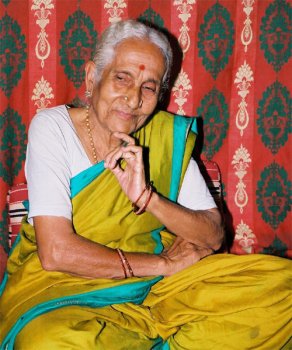
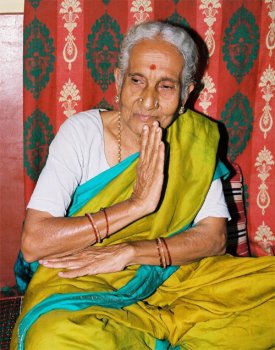
Venkatalakshamma
Venkatalakshamma was nearing seventy and she most often,
taught us from a sitting position. She would sometimes
stand and demonstrate, or even dance, the whole
abhinaya item just for us. I believe we were the
last batch of students to have had this opportunity to
witness Venkatalakshamma dancing. I had a good
rapport with my guru - a very good teacher-student
relationship. Venkatalakshamma taught me the theory and
practice of Bharatanatyam - three different margams
- in Mysore style, which I love. It was also a good base
for my career in dance. Venkatalakshamma was very
particular about tradition, and she taught us the items in
the same way she had learnt from her guru. I never had any
difficulty in understanding the characters, the subtle
nuances, and in expressing my feelings. However,
Venkatalakshamma didn`t agree sometimes with my rendition.
There was a particular syllabus with all the Bharatanatyam items for diploma and degree courses at the University, and I secured the First Rank in both examinations. Gurus US Krishna Rao and Chandrabhaga Devi, the well-known dance duo of Pandanallur style, were my examiners. The selected compositions were mostly in Sanskrit, Telugu and Kannada languages. Venkatalakshamma knew very few items in Tamil, and she was not very much interested in new choreography. I knew that the dance world was as big as an ocean, and I was very fond of languages and was longing to learn different dance styles. Venkatalakshamma personally did not so much appreciate my intentions, and also did not encourage me to go my own way. There were times when we had arguments, a long discussion on a theme between us. But we also used to laugh a lot. I can never forget those interesting conversations we had. She had a great sense of humour. Soon after my education in dance and music at the University in Mysore, I left for Switzerland. However, I used to visit India for a month or two, every year to hone and further my skills in music, yoga and dance - not only Bharatanatyam, but also other dance forms with great teachers. I met many great personalities, and this experience enriched my art and personal life. I would like to mention a few names, all great gurus, who were very kind to me: Mayadhar Raut, Muthuswami Pillai, Maya Rao, Prof. Chandrasekhar and MK Saroja, Pratap Pawar and Priya Pawar, Chitra Visweswaran and many others. Venkatalakshamma used to live with her son Mylarappa, who was not a dancer, in Vani Vilasa Mohalla, Mysore, and was helping her in the household. She was happy with her art and did not believe much in awards. However, many prestigious awards came to her door. The notable awards and titles she received were: 1964 - National Award, presented by Dr S Radhakrishnan, 1976 - Sangeeta Nritya Academy, 1977 - Doctorate, Mysore University, 1988 - Kannada Rajyotsava Award, 1989 - Sangeeta Kalaratna, Bangalore Gayana Samaja, 1992 - Padma Bhushan National Award, 1995 - Natyarani Shantala State Award, 2001 - Nadoja Award, University of Hampi. Interestingly, though she was a great artiste and had received the National Award in 1964, she was not invited to perform elsewhere in India or major cities. She did not travel much. I think she went to Tamil Nadu for the first time, when Sruti Foundation invited her to take part in its 10th Anniversary celebrations in Chennai! Both the Central and the State governments made documentary films on her, when she was quite old. Not many have seen them! Many articles have appeared on her in different magazines and newspapers too. Yet, the Mysore style of dance has not become popular. It is a pity that none of her early students made a career as a performing artist. Also, my seniors and classmates who learnt Bharatanatyam at the University of Mysore didn't take up dance as a profession. Shakuntalamma, who had learnt the Mysore style from her grandmother Venkatalakshamma, also stopped dancing when she got married. Venkatalakshamma retired from her University position in 1974. The same Reader post was given to Shakuntalamma when I was in the final year degree course. After a long break, Shakuntalamma (who also later gave up her job) started teaching and I learnt a few items from her. However, her style was quite different from what I had learned from her grandmother. Venkatalakshamma was a highly respected artist in Karnataka; her quality of dance was compared to the brilliance of the legendary dancer Balasaraswati of Tamil Nadu. After her retirement, Venkatalakshamma's son Mylarappa went back to his village. Venkatalakshamma started to give private lessons to a few students. She did not have a permanent residence, and she lived sometimes at her students' homes or her granddaughter's place. However, the real paradox was, Venkatalakshamma, now 70 +, began to receive invitations to conduct workshops in abhinaya for young and upcoming dancers who were already trained by other teachers of other styles! Also, some of the dance teachers also took short courses from this celebrated specialist of Mysore style. Of course, they could not become proponents of Mysore style. Everybody knows that to integrate the original style of a teacher, a student must study from the beginning with the same teacher, and also intensely keep practising to achieve greater heights in the field. Also, many foreigners came to Mysore for short periods to take lessons from Venkatalakshamma and she imparted her dexterity without prejudice. 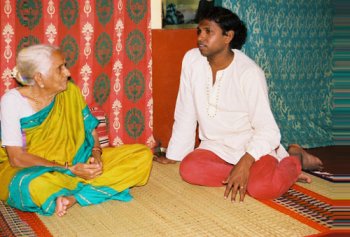 Venkatalakshamma and Keshava (1980) 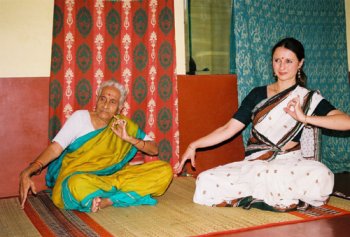 Venkatalakshamma and Esther Jenny (1980) I often came to Mysore with my wife Esther Jenny and our children. We both learnt many (more) abhinaya items from Venkatalakshamma. She attended our performances in Mysore and appreciated my innovations. Naturally, she was getting older and older. She also used to express her unhappiness with the present state of art, and I felt helpless! Finally, she went back to her village Tangli, and lived there till her last day with her son and daughter-in-law. I believe she was happy over there. On July 3, 2002, her soul left her body. The sombre message reached me, the next day. At that time, I was in the US performing in Washington DC. I must say that all my programmes, thereafter, were impromptu Shraddhanjali to my guru. Soon after, I came to India and I was lucky. I was invited by the Kannada and Culture Department to give a Shraddhanjali programme to my guru, with both my daughters, Anjali and Sumitra, in Bangalore. It was indeed a great honour for us! The Mysore Style It is often said or written in articles by critics, writers and journalists that the speciality of Mysore style is the abhinaya in javalis and shlokas. But having learnt from the doyenne of Mysore style, I would say this style has its own way of presenting each item in the Bharatanatyam repertoire. Maybe, rasikas could have witnessed rare performances of Venkatalakshamma as she demonstrated the abhinaya items by sitting on the dais; at her age she was not also able to show the technical part of the Mysore style. In the 1960s and 1970s, there were not many performing artists of this style. It is also a pity that those who had learnt from Venkatalakshamma - her grand-daughter Shakuntalamma, Leelagiri, Krishnaveni and Lalita Kore - did not make a name as performers and did not work much to make it popular. I must say that I was really very lucky to have had Venkatalakshamma as my dance teacher. It was her style that gave me what I needed and made me happy. 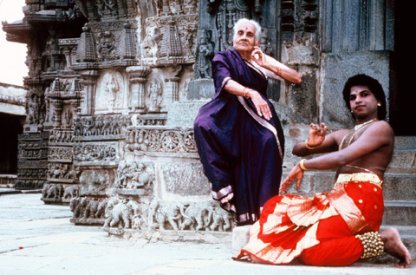 Venkatalakshamma and Keshava at Somnathpur temple (1988) 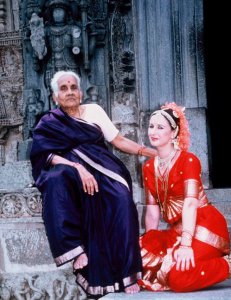 Venkatalakshamma and Esther Jenny at Somnathpur temple (1988) Venkatalakshamma did not teach me only padas and javalis; she also taught me four alaripus - tishra, chaturashra, chanda, and mishra - six jathiswarams in different talas and ragas, four padavarnas, many padams, javalis, shlokas, astapadis, and four tillanas. Of course, I studied this style further more deeply and worked for its development. I taught them to my wife Esther, my children and many students of different nationalities, who are now performing with me. Yes, it is more than three decades since I first learnt this art and I am still teaching it with fidelity to my students in Switzerland. The abhinaya in dance takes an important role to get a good impression of the dancer. The presentation of both satvika (mental) and angika (physical) abhinaya in Mysore style is very different from the Pandanallur and Tanjore styles of Tamil Nadu. If one could judge, it could be said that it is quite similar to the Vazhuvoor style. Mysore style has its own beauty. It is very graceful and dynamic, in the nritta (technical) items - from alaripu to tillana - as the complicated adavus are woven in a beautiful way; the lines are neat, genteel and relaxed; the concluding steps (teermanas) are impressive and interesting. The adavus like natadavu, jaradavu, tatti mettadavu, pakkadau, kudimettadavu, mandiadavu, haradavu, muktayaadavu, charis and bhramaris, are done in a different way than in other styles. In the abhinaya part of adavus, padavarna, a pada or a javali - whatever be the item by way of pantomime - the usage of the hand gestures (hasta prayoga and hasta kshepa), facial expressions, and the movements of limbs, are done in a different manner, sahaja abhinaya - the natural way of expression. Dance is a visual art and one cannot render a crystalline picture of the dance style by writing on it. One should only see, realize and appreciate it. Hope my guru, Venkatalakshamma, would agree! Dasappa Keshava is the Director of Kalasri, school for dance and yoga, in Basel, Switzerland. kalasri.com Post your comments Please provide your name and email id along with your comment. All appropriate comments posted with name & email id in the blog will also be featured in the site. |